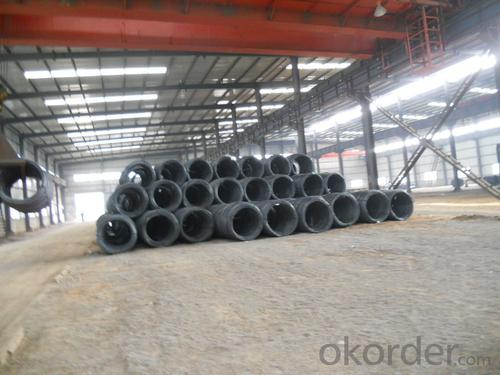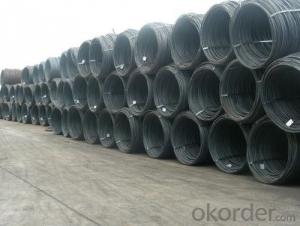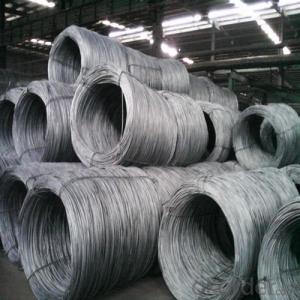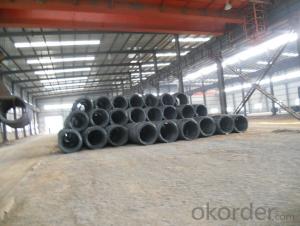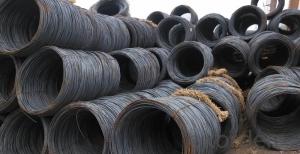Hot Rolled Steel Wire Rode SAE1006~SAE1018,H08A,30MnSi,62B-82B
- Loading Port:
- Tianjin
- Payment Terms:
- TT OR LC
- Min Order Qty:
- 50 m.t.
- Supply Capability:
- 40000 m.t./month
OKorder Service Pledge
OKorder Financial Service
You Might Also Like
Specification
Product Description:
OKorder is offering Hot Rolled Steel Wire Rode SAE1006~SAE1018,H08A,30MnSi,62B-82B at great prices with worldwide shipping. Our supplier is a world-class manufacturer of steel, with our products utilized the world over. OKorder annually supplies products to European, North American and Asian markets. We provide quotations within 24 hours of receiving an inquiry and guarantee competitive prices.
Product Applications:
Hot Rolled Steel Wire Rode SAE1006~SAE1018,H08A,30MnSi,62B-82B are ideal for structural applications and are widely used in the construction of buildings and bridges, and the manufacturing, petrochemical, and transportation industries.
Product Advantages:
OKorder's Hot Rolled Steel Wire Rode SAE1006~SAE1018,H08A,30MnSi,62B-82B are durable, strong, and resist corrosion.
Main Product Features:
· Premium quality
· Prompt delivery & seaworthy packing (30 days after receiving deposit)
· Corrosion resistance
· Can be recycled and reused
· Mill test certification
· Professional Service
· Competitive pricing
Product Specifications:
Steel Grade: Q195 Standard: ASTM, GB
Diameter: 5.5mm, 6.5mm, 7mm,8mm,9mm,10mm,12mm,14mm
6.5mm can be drawing into 2mm/8.0mm can be drawing into 3mm
Type: Drawn Wire in Coil, each coil weight about 2MT
Brand Name: N-RIVER Place of Origin: Hebei, China
Chemical Composition:
Please kindly find our chemistry of our material based on Q195 as below for your information
Trademark | Rank | Chemical composition (quality score) % | |||||
C | Si | Mn | S | P | |||
| ≤ |
| ≤ | ≤ | |||
Q195 |
| 0.06-0.12 | 0.30 | 0.25 | 0.050 | 0.045 | |
Trademark | Rank | Pulling Test | |||||
Bend PointΔs/Mpa | Tensile Strength | Elongation Ratioδ5% | |||||
Thickness (Diameter) /MM | Thickness (Diameter) /MM | ||||||
≤16 | 16-40 | ≤16 | 16-40 | ||||
≥ | ≥ | ||||||
Q195 |
| 195 | 185 | 315-390 | 33 | 32 | |
Usage and Applications of Hot Rolled Wire Rod:
After hot-rolled the products shaped into coil and delivery as finished product, including round, square, rectangular, hexagonal and so on. Since most of the products are round, it is generally called wire rod. Carbon steel wire rod is widely used in construction and manufacturing. Carbon steel wire rod is mainly used for reinforcement of reinforced concrete and welded structure or reprocessed (roberts , nail, etc.) materials, especially used to produce wire drawing, welding electrode, nails, spring, electronic, precise machinery parts and so on.
Packaging & Delivery of Hot Rolled Wire Rod:
Packaging Detail: products are packed in coil, each coil weight around 2 MT, and then shipped by container or bulk vessel
Delivery Detail: within 45 days after received deposit or LC.
Label: to be specified by customer, generally, each bundle has 1-2 labels
Trade terms: FOB, CFR, CIF
FAQ:
Q1: Why buy Materials & Equipment from OKorder.com?
A1: All products offered byOKorder.com are carefully selected from China's most reliable manufacturing enterprises. Through its ISO certifications, OKorder.com adheres to the highest standards and a commitment to supply chain safety and customer satisfaction.
Q2: How do we guarantee the quality of our products?
A2: We have established an advanced quality management system which conducts strict quality tests at every step, from raw materials to the final product. At the same time, we provide extensive follow-up service assurances as required.
Q3: How soon can we receive the product after purchase?
A3: Within three days of placing an order, we will begin production. The specific shipping date is dependent upon international and government factors, but is typically 7 to 10 workdays.
Q4: What makes stainless steel stainless?
A4: Stainless steel must contain at least 10.5 % chromium. It is this element that reacts with the oxygen in the air to form a complex chrome-oxide surface layer that is invisible but strong enough to prevent further oxygen from "staining" (rusting) the surface. Higher levels of chromium and the addition of other alloying elements such as nickel and molybdenum enhance this surface layer and improve the corrosion resistance of the stainless material.
Q5: Can stainless steel rust?
A5: Stainless does not "rust" as you think of regular steel rusting with a red oxide on the surface that flakes off. If you see red rust it is probably due to some iron particles that have contaminated the surface of the stainless steel and it is these iron particles that are rusting. Look at the source of the rusting and see if you can remove it from the surface.
Images:



- Q: What are the common applications of pre-stressed concrete steel wire rod?
- Pre-stressed concrete steel wire rods are widely used in various applications due to their high strength and durability. Some of the common applications of pre-stressed concrete steel wire rods are: 1. Buildings and Infrastructure: Pre-stressed concrete steel wire rods are commonly used in the construction of buildings, bridges, highways, and other infrastructure projects. They provide added strength and load-bearing capacity to the structures, making them resistant to bending, cracking, and other forms of structural failure. 2. Post-tensioning Systems: Pre-stressed concrete steel wire rods are extensively used in post-tensioning systems. These systems involve the insertion of pre-stressed steel wire rods into concrete structures and then applying tension to them. This process helps to counteract the tensile forces that concrete structures experience, thereby improving their overall strength and durability. 3. Precast Concrete Products: Pre-stressed concrete steel wire rods are also used in the production of precast concrete products such as beams, columns, slabs, and walls. By incorporating pre-stressed steel wire rods during the manufacturing process, these products gain enhanced strength and resistance to cracking, allowing for longer spans and thinner sections. 4. Retaining Walls: Pre-stressed concrete steel wire rods play a crucial role in the construction of retaining walls. These walls are designed to retain soil and prevent erosion. By integrating pre-stressed steel wire rods into the concrete structure, the retaining walls become more robust, ensuring stability and preventing any potential failure due to the pressure exerted by the retained soil. 5. Seismic Resistant Structures: Pre-stressed concrete steel wire rods are especially valuable in seismic regions where earthquakes are a concern. By incorporating pre-stressed steel wire rods into the concrete elements of buildings and infrastructure, their ability to withstand seismic forces is significantly increased. This helps to minimize damage and ensure the safety of occupants during earthquakes. Overall, the common applications of pre-stressed concrete steel wire rods encompass a wide range of construction projects, where their strength, durability, and ability to withstand various forces are essential.
- Q: How are steel wire rods used in the manufacturing of fishing nets?
- Steel wire rods are an essential component in the manufacturing of fishing nets. These rods serve as the skeletal structure of the net, providing strength and durability to withstand the harsh conditions of fishing. To begin the manufacturing process, the steel wire rods are first straightened and cut into various lengths, depending on the desired size of the net. These rods are then woven or knotted together to form the net's framework. The tight weaving ensures that the net is sturdy enough to withstand the pressure of catching fish and resist breaking or tearing. The steel wire rods used in fishing nets are specifically chosen for their high tensile strength and corrosion resistance. This makes them suitable for enduring the corrosive effects of saltwater, as fishing nets are primarily used in marine environments. Additionally, the steel wire rods are often coated with a protective layer, such as zinc or PVC, to further enhance their durability and prevent rusting. Furthermore, the flexibility of steel wire rods allows the fishing net to adapt to different shapes and sizes. This flexibility is crucial as it enables the net to conform to the contours of the water, maximizing its effectiveness in capturing fish. In conclusion, steel wire rods play a vital role in the manufacturing of fishing nets, providing the necessary strength, durability, and flexibility. Their high tensile strength and corrosion resistance make them an ideal choice for withstanding the harsh conditions of fishing. Without these steel wire rods, the manufacturing of fishing nets would not be possible, and the fishing industry would be greatly impacted.
- Q: What are the different types of steel wire rod surface defect repair and rework techniques?
- There are several techniques used to repair and rework surface defects on steel wire rods. Some common methods include grinding or sanding the affected area to remove the defect, applying a weld or filler material to fill in the defect, and then grinding or sanding the repaired area to smooth it out. In some cases, heat treatment may be used to remove or reduce certain types of defects. Additionally, surface defects can also be repaired by using chemical treatments or coatings to improve the appearance and integrity of the wire rod surface.
- Q: How is steel wire rod used in the manufacturing of wire forms for electrical connectors?
- Steel wire rod is an essential component in the manufacturing of wire forms for electrical connectors. The wire rod serves as the raw material that is transformed into various wire forms, such as pins, sockets, and terminals, which are crucial components of electrical connectors. The manufacturing process begins with the selection of high-quality steel wire rod, which is typically made of carbon steel or stainless steel. The wire rod is carefully chosen based on its specific properties, such as strength, flexibility, and conductivity, to ensure that the resulting wire forms meet the required standards and specifications. Once the appropriate wire rod is selected, it undergoes a series of manufacturing operations. The first step is to draw the wire rod through a series of dies and reduce its diameter to the desired size. This process is known as wire drawing and is performed to achieve the required thickness and smoothness of the wire form. After wire drawing, the wire rod is then straightened and cut into specific lengths. These lengths are determined based on the design and dimensions of the wire forms required for the electrical connectors. The straightening and cutting process ensures that the wire forms are uniform and consistent in size. The next step involves bending and shaping the wire rod into the desired form. This is typically achieved through the use of specialized machines and tools that can bend the wire rod into various configurations, such as loops, hooks, or specific geometrical shapes. These wire forms are designed to fit and connect with other components of the electrical connectors. Once the wire forms are shaped, they undergo additional processes such as heat treatment or plating to enhance their mechanical properties or improve their resistance to corrosion. These treatments ensure that the wire forms can withstand the demanding conditions and provide reliable connectivity in electrical applications. In conclusion, steel wire rod plays a critical role in the manufacturing of wire forms for electrical connectors. Through a series of manufacturing processes, the wire rod is transformed into various wire forms that are essential components of electrical connectors. These wire forms provide reliable connectivity and ensure the proper functioning of electrical systems.
- Q: How is the bending properties of steel wire rod tested?
- The bending properties of steel wire rod are typically tested through a method called the bend test. In this test, a sample of the wire rod is bent to a specific angle or curvature and then examined for any signs of cracking or breaking. The test is conducted by securing one end of the wire rod and applying a force to the other end to bend it. The amount of force required to achieve the desired bend is measured, and the wire rod is visually inspected for any signs of deformation or fracture. Additionally, the test may involve measuring the diameter of the wire rod before and after bending to assess any changes in its physical properties. The bend test provides valuable information about the flexibility and ductility of the steel wire rod, which is crucial in determining its suitability for various applications.
- Q: How is the brittleness of steel wire rod determined?
- The brittleness of steel wire rod is typically determined by conducting a series of mechanical tests, such as the Charpy impact test or the tensile test. These tests help measure the amount of force or energy required to fracture or break the steel wire rod, providing an indication of its brittleness. Additionally, microscopic examination techniques, like optical microscopy or scanning electron microscopy, can be used to analyze the internal structure of the steel wire rod and identify any signs of brittleness, such as the presence of cracks or grain boundaries.
- Q: How are steel wire rods used in the manufacturing of mesh screens?
- Mesh screens rely heavily on steel wire rods as a fundamental ingredient in their production. These rods are typically crafted from top-notch steel, known for its robustness, longevity, and resistance to corrosion. The initial step involves selecting the appropriate grade of steel wire rod, based on the desired specifications for the mesh screen. The steel wire rods undergo a series of processes to prepare them for use. These processes include cleaning, straightening, and cutting, ensuring that the rods are devoid of impurities and possess the correct dimensions. Once the wire rods are prepared, they are fed into a mesh weaving machine. This machine is equipped with multiple weaving heads, which intertwine the wire rods both horizontally and vertically, creating a grid-like structure. The interlacing process can be performed in various patterns, such as plain weave, twill weave, or Dutch weave, depending on the intended application of the mesh screen. Throughout the weaving process, the steel wire rods are tightly woven together, resulting in a mesh that is both sturdy and flexible. This mesh structure offers numerous advantages, including heightened strength, resilience, and resistance to deformation. Following the weaving process, the mesh screens may undergo additional treatments to further enhance their properties. These treatments may involve heat treatment or surface coating, aiming to augment the mesh's resistance to rust, abrasion, or chemical corrosion, depending on the specific requirements of its application. In summary, steel wire rods play a pivotal role in the production of mesh screens by providing the essential material for weaving the mesh structure. The resulting mesh screens find application in diverse industries, such as construction, mining, agriculture, filtration, and security, among others. Their versatility, strength, and durability make them an ideal choice for a wide range of applications.
- Q: What are the different types of steel wire rod coatings used for improved heat resistance?
- There are several types of steel wire rod coatings used for improved heat resistance. Some common coatings include zinc-based coatings, aluminum-based coatings, and ceramic coatings. These coatings provide a protective barrier that enhances the wire rod's ability to withstand high temperatures and prevent oxidation or corrosion. Additionally, these coatings can also improve the wire rod's overall durability and longevity in high-temperature environments.
- Q: What are the common industry competencies for steel wire rod professionals?
- Some common industry competencies for steel wire rod professionals include knowledge of steel production processes, understanding of quality control and testing procedures, proficiency in operating and maintaining machinery and equipment, familiarity with industry safety regulations, ability to interpret and analyze technical data and specifications, and effective communication and teamwork skills.
- Q: What are the different types of coatings used on steel wire rod?
- There are several different types of coatings that can be used on steel wire rods. Some common examples include zinc coatings, which provide corrosion resistance; copper coatings, which enhance conductivity; and polymer coatings, which offer protection against abrasion and wear. Other types of coatings may include aluminum, tin, or nickel, depending on the specific application and desired properties.
Send your message to us
Hot Rolled Steel Wire Rode SAE1006~SAE1018,H08A,30MnSi,62B-82B
- Loading Port:
- Tianjin
- Payment Terms:
- TT OR LC
- Min Order Qty:
- 50 m.t.
- Supply Capability:
- 40000 m.t./month
OKorder Service Pledge
OKorder Financial Service
Similar products
Hot products
Hot Searches
Related keywords




